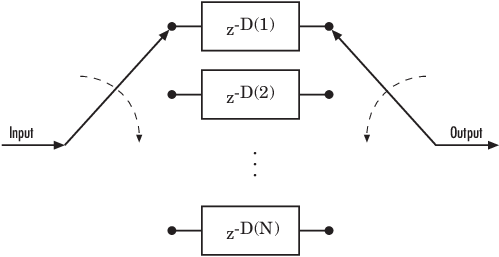comm.ConvolutionalInterleaver
Permute symbols using set of shift registers with specified delays
Description
The comm.ConvolutionalInterleaver
System object™ permutes the symbols in the input sequence by using a set of shift registers,
each with its own delay value. For information about delays, see Delays of Convolutional Interleaving and Deinterleaving.
To permute symbols using a set of shift registers with specified delays:
Create the
comm.ConvolutionalInterleaverobject and set its properties.Call the object with arguments, as if it were a function.
To learn more about how System objects work, see What Are System Objects?
Creation
Description
intrlvr = comm.ConvolutionalInterleaver
intrlvr = comm.ConvolutionalInterleaver(Name=Value)NumRegisters=10 specifies 10 internal shift registers.
Properties
Usage
Description
intrlvseq = intrlvr(inputseq)
For information about delays, see Delays of Convolutional Interleaving and Deinterleaving.
Input Arguments
Output Arguments
Object Functions
To use an object function, specify the
System object as the first input argument. For
example, to release system resources of a System object named obj, use
this syntax:
release(obj)
Examples
More About
References
[1] Clark, George C., and J. Bibb Cain. Error-Correction Coding for Digital Communications. Applications of Communications Theory. New York: Plenum Press, 1981.
[2] Forney, G., D., Jr. "Burst-Correcting Codes for the Classic Bursty Channel." IEEE Transactions on Communications, vol. COM-19, October 1971. 772-781.
[3] Ramsey, J. L. "Realization of Optimum Interleavers." IEEE Transactions on Information Theory, IT-16 (3), May 1970. 338-345.
Extended Capabilities
Version History
Introduced in R2012a
See Also
Objects
comm.ConvolutionalDeinterleaver|comm.gpu.ConvolutionalInterleaver|comm.HelicalInterleaver|comm.MultiplexedInterleaver
